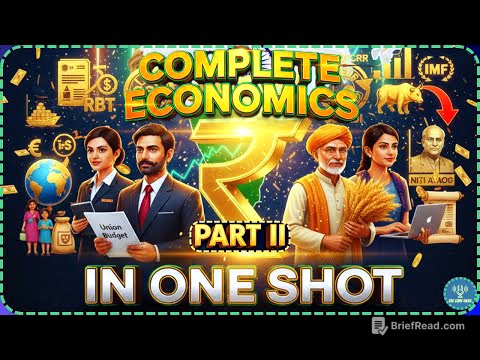TLDR;
The video analyses India's self-proclaimed status as a rising global superpower, contrasting it with international perceptions. It highlights discrepancies between India's self-image and its actual capabilities, focusing on overstated GDP figures, military underperformance, declining manufacturing, and a preference for symbolic gestures over substantive progress. The video suggests that India's focus on optics and branding is hindering its progress compared to other nations that are quietly building their economies and industries.
- India's GDP may be overstated due to changes in calculation methods.
- India's military capabilities do not match its perceived image.
- India is overly focused on symbolism and branding over substantive development.
Forbes Ranking and India's Self-Perception [0:01]
In early 2025, Forbes released a list of the top 10 most powerful countries, which included the United States, China, Russia, the United Kingdom, Germany, South Korea, France, Japan, and Saudi Arabia. India was ranked 12th, which is notable because India has been promoting itself as a rising global superpower. Despite politicians and news channels celebrating various achievements as proof of India's rise, the world doesn't seem to fully accept this narrative. Canada, often overlooked in Indian media, ranked higher at 11th place, highlighting a growing disparity between India's self-perception and the world's view of India.
GDP Overstatement and Economic Reality [1:09]
India has been using its GDP growth as evidence of its rise, surpassing countries like the United Kingdom and France. However, economist Aaron Kumar suggests that India's GDP may be overstated by as much as 42% due to changes in calculation methods implemented by the Modi government. These new formulas make growth appear faster and more impressive, but they don't reflect the reality on the ground. Youth unemployment remains high, infrastructure gaps are significant, and manufacturing, which is crucial for industrial growth, accounts for less than 15% of India's economy and is declining. India's economy still relies heavily on agriculture and low-end services, which do not indicate true industrial power.
Military Image vs. Performance [2:23]
India portrays itself as a top-tier military power with the world's fourth-largest armed forces and advanced jets like the Rafale. However, real combat situations reveal a different story. The 2019 India-Pakistan air skirmish, where an Indian pilot was shot down and captured, exposed the Indian air force's unpreparedness. In the 2020 Galwan Valley clash, Indian troops were overwhelmed by Chinese forces despite having greater numbers. A fictionalised 2025 India-Pakistan air battle further highlighted potential weaknesses. These incidents expose a gap between India's military image and its actual performance, stemming from outdated equipment, inadequate training, and morale issues.
Global Indifference and Cooling Enthusiasm [3:52]
India is facing indifference from the international community. The United States and its allies initially sought to include India in strategic alliances like the Quad to counter China, but enthusiasm has waned due to India's underperformance in military, economic, and diplomatic areas. During a reported 2025 India-Pakistan air battle, US officials dismissed it as irrelevant to American interests, marking a significant shift in perception. Canada's higher ranking than India in the 2025 Forbes power list reflects its stable economy, high-tech manufacturing, strong institutions, and reliable alliances. India is often viewed as politically unpredictable and focused on symbolism over substance. Financial institutions like Moody's have downgraded India's credit outlook, citing concerns over data manipulation and governance, while major media outlets question the credibility of India's claims.
Other Nations' Progress and India's Stagnation [5:36]
While India focuses on becoming a superpower, other nations like Mexico, Brazil, and ASEAN countries are quietly making progress. Mexico and Brazil are expanding their industrial output and attracting investment without grand announcements. ASEAN nations like Vietnam, Indonesia, and Malaysia are focusing on regional trade, manufacturing competitiveness, and education reforms. Vietnam's manufacturing exports rival India's despite its smaller size, and Indonesia is developing an EV battery ecosystem. These countries demonstrate real strategies with measurable progress, while India remains stuck in a cycle of big talk and slow action, with delays and reversals in policy implementation.
The Myth of India as the Next China [7:12]
India has long aspired to be the next China, a manufacturing giant and tech powerhouse, but this dream remains distant. Manufacturing's share of India's GDP has fallen below 15%, indicating a decline rather than a rise in industrial power. India is becoming more agrarian, with a large population still dependent on farming. The economic conflict between the US and China has negatively impacted India, particularly due to its reliance on imports. India's $100 billion trade deficit with China symbolises dependence. Despite initiatives like "Make in India" and "Digital India," the country still imports essential goods like smartphones, semiconductors, and military components. While India discusses becoming a chip superpower, countries like Taiwan and South Korea are actually producing the chips.
Internal Self-Deception and Vanity Politics [8:54]
India's primary obstacle is internal self-deception. Indian politics has transformed national development into a branding exercise, with slogans overshadowing substantive reforms in education, industrial policy, defence R&D, and institutional capacity. The focus is on symbolism over substance, such as fighter jet prototypes without engines and inflated GDP figures. The AMCA fighter jet project, showcased as a fifth-generation leap, lacks a domestically built engine and relies on foreign imports. This obsession with appearing powerful distracts from the essential work of building world-class institutions and infrastructure. This creates a feedback loop where leaders are praised for appearances rather than performance. India's focus on pageantry is becoming a weakness as other nations advance through tangible actions. Vanity politics undermines credibility both domestically and internationally.
Conclusion: Rebuilding the Core [10:37]
India, with its vast population and potential, should be a global powerhouse, but potential requires action. The Forbes ranking reflects deeper issues such as overstated GDP, fragile military readiness, declining manufacturing, rising dependency, and a focus on appearance over achievement. While other countries strengthen their industries and invest in innovation, India is engaged in national optics, mistaking social media pride for global respect. The world values tangible strength, such as functional jets, advanced chips, reliable infrastructure, and robust institutions. For India to lead, it must stop inflating its image and start rebuilding its core through honest data, deep reform, empowered engineers, and leaders who prioritise execution over theatrics. In the global race, nations rise by building, not boasting.









